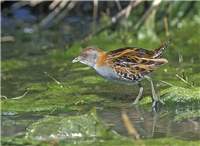Family
Rallidae
Genus
Porzana
Species
pusilla
Threats/Control Methods - Regional
Land clearing of the ideal wetland areas and their vegetation is leading to the decline of this species in some areas. Predation from birds of prey or feral and domestic Dogs (Canis familiaris) and Cats (Felis catus) lead to deaths, especially among young birds.
Threats/Control Methods - Local
Predation by free roaming domestic pets around lakeside areas is an ongoing threat to this species, as are the waterfront developments that remove lakeside vegetation. In particular, the Jerrabomberra Creek Catchment, home to many of the local crakes, is currently degraded from grazing, polluted stormwater from the Hume industrial estate, road surface runoff and rural residential developments.
Local/Urban Actions
Improving the riparian vegetation around rivers and waterways is a great way to help local waterbird species. Plantings can be organised through Greening Australia and Landcare. Dog walkers should keep pets on a lead and to collect all faeces and dispose of it in rubbish bins. Cat owners can prevent their pets from hunting by installing a cat run or enclosure.
Common Names
Ballion's Crake, Marsh Crake, Little Crake, Little Water Crake
Distinguishing Features
This small waterbird of 15-16cm has a round body on strong legs, with a slightly leaning forward posture. They have a red eye and a red-brown coloured head, back, wings and tail, streaked with black and white throughout. The face, throat and breast are a grey-blue colour, while the rump and under tail is striped black and white. The legs and bill are an olive-yellow colour.
Survey Techniques
Call and visual identification.
Species Call
A loud, sharp, metallic 'chak-ak-ak-akakakak'.
Similar Species
The Australian Spotted Crake (Porzana fluminea) is very similar in size, shape and colourings. However, the red patch on its bill and the white spots across its plumage make it unique.
Distribution
This species is widely distributed across southern Africa, Europe and Asia, from Spain to Japan and down through the coastal and wetland regions of Australia and New Zealand.
Country of Origin
The Eurasian continent.
Conservation (Pet/Pest) Status - Regional
This species is rare to the Canberra region, with most records from the Jerrabomberra Wetlands.
Conservation (Pet/Pest) Status - National
Secure, not listed under the EPBC Act 1999. This Crake is common to southeastern Australia, but declining in the north.
LSCCES Population
11 sightings were made at the peninsula of the National Museum of Australia.
Associated vegetation community
These birds inhabit damp areas with dense cover, either in fresh or saline wetlands and swamps of both shallow and deep waters. They are not well suited to human modified environments and are limited to areas that are generally difficult to access by humans.
Limiting Resources
These birds inhabit damp areas with dense cover, either in fresh or saline wetlands and swamps of both shallow and deep waters. They are not well suited to human modified environments and are limited to areas that are generally difficult to access by humans.
Breeding
The Baillon's Crake breeds from August to January, building a well-hidden nest in the thick vegetation surrounding a swamp or lake. The nest itself is a shallow bed of reeds, grasses and aquatic vegetation, with plants pulled over the top in a canopy and a ramp of vegetation leading from the water to the nest. The 5-6 eggs are brown with dark smudges and streaks. Both sexes incubate for 16-18days and young birds are expected to leave the nest after about 35 days.
Behaviour
This bird is less shy than some other of the crake species, however it has a nervous nature and usually only ventures out of its thick vegetation cover very early in the morning or late in the evening. It will become bold while nesting, refusing to leave the nest and pecking at the hands of anyone who tries to come too close. It can be seen foraging through floating vegetation for food, with its tail upright and its long toes enabling it to skate across the water on pieces of vegetation. It sometimes flies up to nearby tree branches to preen its feathers.
Functional Group
Food Species
The Baillon's Crake has a varied diet of small invertebrates, insects, spiders, small shellfish and also young plant shoots and seeds.
Predators
Snakes and other reptiles heavily predate the eggs and young of the Baillon's Crake. Swamp Harriers (Circus aeruginosus) and other large birds of prey are known to take birds of all ages. Feral or domestic Dogs (Canis familiaris) and Cats (Felis catus) pose a threat to birds in the nest.
Interesting Fact
In the nesting season this usually shy bird becomes extroverted, preforming distracting displays through the reeds and splashing the water to distract any observers from the whereabouts of the nest.
References - (reader suitability of references, P=Primary teachers, S=Secondary students, T=Tertiary students and researchers)
Books:Morcombe, M. 2000. Field Guide to Australian Birds. Steve Parish Publishing. Archerfield. Australia P, S, T
Pringle, J. 1985. The Waterbirds of Australia. Angus and Robertson/National Photographic Index of Australian Wildlife. Sydney. P, S, T
Taylor, M. and Day, N. 1993. Field Guide to the Birds of the ACT. National Park Association of the ACT Inc. Canberra. P, S, T
Internet: Canberra Ornithological Group (COG). 2004. Birds of Canberra Gardens. COG and the ACT Department of Urban Services. [online]. Available at:http://garden.canberrabirds.org.au/ P, S, T
Online Publications: Nix, H. and Cunningham, R. 2006. Birds of the Lower Sullivans Creek Catchment, Canberra ACT. Prepared for the Life in the Suburbs project using data from the Lower Sullivans Creek Catchment Ecological Survey (LSCCES). Australian National University. Canberra. [online]. Available at: http://www.lifeinthesuburbs.com.au/category.php?id=65 S, T
Queanbeyan City Council. 2004. Study on the Current State of Jerrabomberra Creek . Maunsell Australia Pty Ltd. Canberra. [online]. Available at: http://www.qcc.nsw.gov.au/Documents/YRJTKVCEDKP.pdf S, T

 Top
Top Top
Top